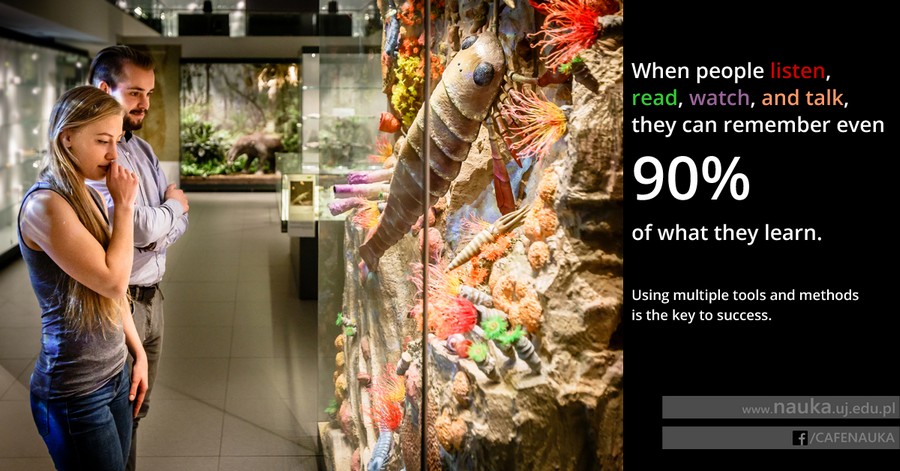
Here is a short guide for those who would rather spend September enjoying last weeks of holidays than struggling with resit exams.
As exam period is rapidly approaching, your resolutions to study hard made at the beginning of the semester are confronted with reality. After all, the FIFA World Cup takes place only once in four years and, besides, anything seems better than reading through lecture notes. But don’t panic - there is still a chance!
Repetition is the mother of learning
First and foremost, be warned that this article is not a guide on how to effectively prepare for an exam in early medieval history in one hour. Neither is it a recipe for a magic potion that will make you omniscient during the 90 minutes of the exam. Instead, we would like to present some learning methods which are more effective than reading lecture notes for several hours and repeating them like a mantra.
First of all, it’s worth realising what the process of learning actually is. According to psychology textbooks, learning is the modification of an individual’s behaviour as a result of his or her experiences. It can also be understood as the multiplication of experience – the more you’ve experienced, the more you know.
According to psychology textbooks, learning is the modification of an individual’s behaviour as a result of his or her experiences
In research papers on learning a lot of focus is placed on memory, which, according to one of the textbooks (Psychologia pamięci, p. 21) can be defined as ‘the ability to encode, store and access information; a hypothetical system storing information in the brain; an internal record of information; an internal representation of previous experience, a set of processes responsible for the creation of internal representation of previous experience, as well as storing and accessing it later.”
One of the interesting issues studied by memory researchers is related to the concept of engram – a memory trace in the brain. According to a hypothesis proposed by the German biologist Richard Semon, it’s a place in the brain where the acquired knowledge is stored. Today it is thought that memory is dispersed over different parts of the brain, but specific parts of this organ are used to store different aspects of what we remember. The information about the world isn’t located in single neurons, but in dispersed groups of neurons.
Each person has their own unique learning style. The entire system of education, primarily based on universality principle, lacks individualised approach towards each student. There are many reasons for this situation, including the most pragmatic one: such a large number of students makes the master-pupil relationship impossible; a teacher finds it impossible to know his or her students well enough to effectively apply individualised teaching tools and methods. In higher education, the situation is improved by the fact that adult students, who have been learning for more than a decade, may already know which methods are most effective for them. What’s more, some university courses provide at least some semblance of the master-pupil relationship, which helps to individualise the teaching process.

Types of intelligence
In 1983 the American psychologist Howard Gardner proposed the Multiple Intelligences Theory, in which he indentified eight types of intelligence, unevenly distributed in the population. As far as education is concerned, it’s crucial to choose the learning technique best suited to the individual talents. For instance, a person with a high level of linguistic intelligence is good at learning from notes, whereas those with high musical-rhythmic intelligence will probably achieve best results when learning aloud. Individuals who have well-developed logical-mathematical intelligence learn most effectively by solving problems and riddles. If you excel at bodily-kinesthetic intelligence, you are probably good at dancing and sport and your learning strategy should involve using tangible objects. People with high visual-spatial intelligence tend to achieve best results in the area of plastic arts and their learning should involve visual models, whereas those with well-developed naturalistic intelligence like doing experiments, seeing scientific exhibitions and watching scientific films. Children with high intrapersonal intelligence can be described as philosophically-minded: they seek answers to difficult questions and like to learn on their own. On the other hand, well-developed interpersonal intelligence means preference for group work and good conflict-solving skills. Such persons often become group leaders.A short summary
Believe it or not, learning can be fun! But in order to enjoy it you have to remember about several important rules.
The more often you learn, the better effect you achieve. Yet, this doesn’t mean that you have to spend long hours learning. It’s the intensity and frequency that matter. For instance, if you have one week to learn for a test, it’s best to divide the material into several smaller parts and each day focus on one of them. It’s better to learn one hour a day than do it throughout the day before the test.
The brain can be trained like muscles. The optimal conditions for such training include a variety of stimuli (a typical academic lecture provides relatively few stimuli) and a comfortable learning environment.
All in all, the brain needs diversity and creativity in terms of sources of knowledge. You can be like Muhammad Ali, whose training schedule was based on constant alteration of exercises and avoided focusing on one single element for too long. He became a master, you also can!
Sources:
Dydaktyka ogólna, Cz. Kupisiewicz, Warszawa 2000.
Psychologia pamięci: badania, teorie, zastosowania, M. Jagodzińska, Gliwice 2013.
Uczymy się uczyć, Cz. Plewka, M. Taraszkiewicz, Szczecin 2010.
Sztuka nauczania, K. Konarzewski, Warszawa 2004.
Neurodydaktyka czyli nauczanie i uczenie się przyjazne mózgowi, M. Żylińska, Gdynia 2013.
Włam się do mózgu, R. Kotarski, Warszawa 2017.
The article was written with the assistance of Małgorzata Turczyk from the Department of School Pedagogy and Academic Teaching of the Jagiellonian University Institute of Pedagogy.
Original text by Kamil Sikora at www.nauka.uj.edu.pl





